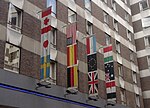Centre for History in Public Health, London School of Hygiene and Tropical Medicine
Health policyHistory of medicine in the United KingdomLondon School of Hygiene & Tropical MedicineSchools of public health
The Centre for History in Public Health (CHiPH) is an academic research centre at the London School of Hygiene & Tropical Medicine (LSHTM), University of London. It specializes in historical research into public health and health services, and advocates the use of history within public health policy making.
Excerpt from the Wikipedia article Centre for History in Public Health, London School of Hygiene and Tropical Medicine (License: CC BY-SA 3.0, Authors).Centre for History in Public Health, London School of Hygiene and Tropical Medicine
Tavistock Place, London St Pancras (London Borough of Camden)
Geographical coordinates (GPS) Address Nearby Places Show on map
Geographical coordinates (GPS)
| Latitude | Longitude |
|---|---|
| N 51.5253 ° | E -0.1267 ° |
Address
Tavistock Place 11
WC1H 9RU London, St Pancras (London Borough of Camden)
England, United Kingdom
Open on Google Maps









